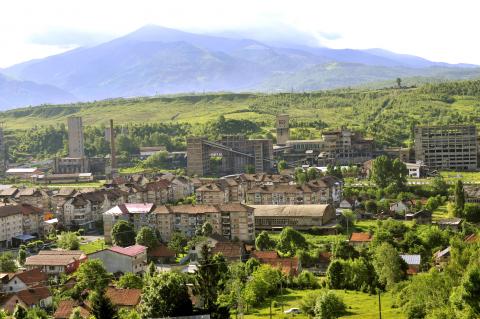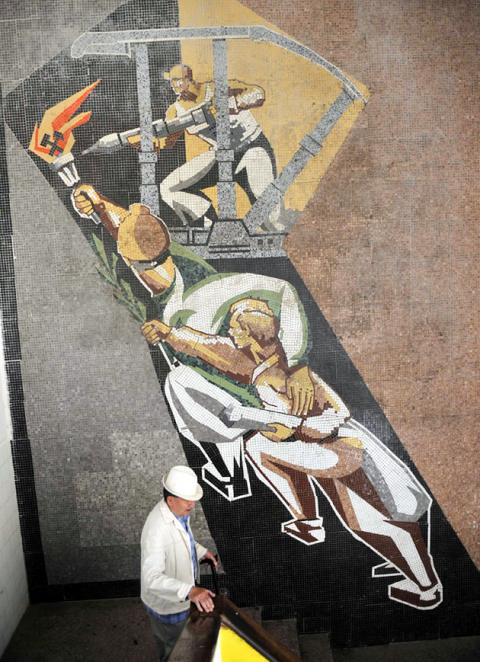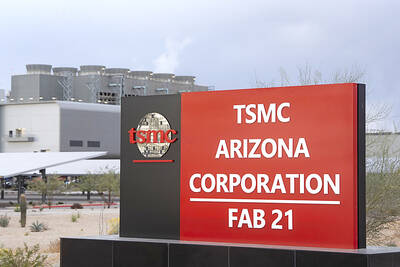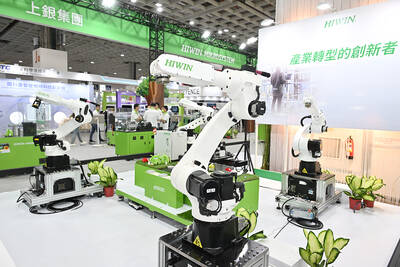At the foot of the majestic Carpathian mountains, Petrila waits in dread for the closure of its coal mine, the oldest in Romania and the life force of a town struggling to survive.
“We are already the valley of tears; we don’t want to become the valley of death,” one resident said, referring to the Jiu Valley where Petrila lies, Romania’s main coal mining region where miners’ numbers have dwindled to only a fraction of those employed in the 1990s.
Petrila’s 153-year-old mine has not only been the town’s livelihood, but its very identity. Petrila without mines would be like Bordeaux without its vineyards or Silicon Valley without its IT firms, locals say.

Photo: AFP
However, pressure from the European Commission, the EU executive, on member governments to cut subsidies to lossmaking mines means the one in Petrila, two elsewhere in Romania and several others across the 27-member bloc will be shut down by 2018. Demolition work has already started.
“It’s the age-old story of the deindustrialization of Europe,” said David Schwartz, a Bucharest director who recently drew attention for Underground, a play he and the well-known Romanian playwright Mihaela Michailov worked on for a year, giving voice to the miners and their families in this once-prosperous company town.
The EU’s plan is to shift subsidies from mines toward renewable energies. Up to 30,000 jobs, out of a total 100,000 in the EU mining sector, could be lost.

Photo: AFP
In Spain, angry miners have staged protests and clashed with police, but those in Romania appear resigned to their fate, still smarting from violent protests in 1990 that many feel stigmatized them wrongly.
That year, then-Romanian president Ion Iliescu called about 10,000 Jiu Valley miners to Bucharest to end protests against his government, the first elected after the fall of the communist regime, but one made up mostly of former communists, like himself.
The miners were severely criticized for using force against protesters, but many today say those who took part were “manipulated.”
Communist-era mosaics at the Petrila mine are a reminder of its flourishing past before the economic decline of the last two decades.
In 1988, the town had about 4,000 miners, now there are 688. In the wider Jiu Valley, numbers have dropped from 50,000 to 7,600, Petrila mine director Constantin Jujan said.
“In 1997, a wave of redundancies at the time meant people suddenly got a lot of money. But they weren’t ready; they spent, they set up businesses and got in debt, found themselves without homes, with nothing,” said local restaurant owner Elena Chelba, whose husband and father are both miners.
Today the unemployment rate in the town is more than 40 percent.
Charity shops proposing second-hand clothes, crockery and toys are testimony to the hard times.
“I don’t know if things can get any worse,” Chelba said. “But if the mine closes, things will not be rosy; so many people depend on it.”
Everyday, ignoring the danger, dozens of locals jump on the trains bringing coal to Petrila to steal a few lumps, either to keep warm or to sell.
One of them, who gave only his first name, Traian, collects what coal he finds on the tracks in red buckets — there is no way his pension of 200 euros (US$244) a month can pay for heating.
Traian’s son has left Romania for Germany, and his daughter will join him for two months of seasonal work. Like many, Traian doesn’t complain for himself, but worries about his children. Emigration is often seen as the only answer.
“My daughter’s future is not here,” one miner said solemnly, tramping out of the mine after a night’s work.
“Some families cannot pay their gas and electricity bills any more. We give them clothes so their children are not ashamed to go to school,” said Florin Popescu, who runs the local branch of Save the Children.
The center ensures that about 100 children get a hot meal, as well as psychological and educational help.
“We know that we will have to leave because there is no work here. It’s sad for me because this is where I have grown up and where my friends are,” said Cristinel Homoc, a 15-year-old who dreams of becoming a soccer player or a lawyer.
Some residents hope for better days in a region that they believe has immense tourism potential.
Stretching about 1,500km across central Europe, the Carpathians are blessed with virgin forest, rich flora and wildlife, including lynx and bears.
Romanian culture is also a draw. A local caricaturist, Ion Barbu, organizes festivals and has turned the childhood home of writer Ion D. Sirbu — a key opposition figure during Nicolae Ceausescu’s dictatorship — into a museum.
Barbu, like many other residents, wants to preserve the buildings at the mine site to create cultural and “industrial” tourism, to retain Petrila’s link with its prouder past.
Industrial tourism has worked in other areas: UNESCO designated three former mining sites in the Wallonia region of southern Belgium and one site in northern France as World Heritage sites.
However, the residents’ dreams have met with opposition from Petrila deputy mayor Constantin Ramascanu, who would prefer to raze the site.
Rejecting all ideas of green tourism — even from Britain’s Prince Charles, who has tried to develop rural tourism in Romania — Ramascanu’s vision is a valley covered in hotels, casinos and quad-biking tracks.

Taiwan Semiconductor Manufacturing Co (TSMC, 台積電), the world’s biggest contract chipmaker, booked its first-ever profit from its Arizona subsidiary in the first half of this year, four years after operations began, a company financial statement showed. Wholly owned by TSMC, the Arizona unit contributed NT$4.52 billion (US$150.1 million) in net profit, compared with a loss of NT$4.34 billion a year earlier, the statement showed. The company attributed the turnaround to strong market demand and high factory utilization. The Arizona unit counts Apple Inc, Nvidia Corp and Advanced Micro Devices Inc among its major customers. The firm’s first fab in Arizona began high-volume production

VOTE OF CONFIDENCE: The Japanese company is adding Intel to an investment portfolio that includes artificial intelligence linchpins Nvidia Corp and TSMC Softbank Group Corp agreed to buy US$2 billion of Intel Corp stock, a surprise deal to shore up a struggling US name while boosting its own chip ambitions. The Japanese company, which is adding Intel to an investment portfolio that includes artificial intelligence (AI) linchpins Nvidia Corp and Taiwan Semiconductor Manufacturing Co (TSMC, 台積電), is to pay US$23 a share — a small discount to Intel’s last close. Shares of the US chipmaker, which would issue new stock to Softbank, surged more than 5 percent in after-hours trading. Softbank’s stock fell as much as 5.4 percent on Tuesday in Tokyo, its

COLLABORATION: Softbank would supply manufacturing gear to the factory, and a joint venture would make AI data center equipment, Young Liu said Hon Hai Precision Industry Co (鴻海精密) would operate a US factory owned by Softbank Group Corp, setting up what is in the running to be the first manufacturing site in the Japanese company’s US$500 billion Stargate venture with OpenAI and Oracle Corp. Softbank is acquiring Hon Hai’s electric-vehicle plant in Ohio, but the Taiwanese company would continue to run the complex after turning it into an artificial intelligence (AI) server production plant, Hon Hai chairman Young Liu (劉揚偉) said yesterday. Softbank would supply manufacturing gear to the factory, and a joint venture between the two companies would make AI data

The Taiwan Automation Intelligence and Robot Show, which is to be held from Wednesday to Saturday at the Taipei Nangang Exhibition Center, would showcase the latest in artificial intelligence (AI)-driven robotics and automation technologies, the organizer said yesterday. The event would highlight applications in smart manufacturing, as well as information and communications technology, the Taiwan Automation Intelligence and Robotics Association said. More than 1,000 companies are to display innovations in semiconductors, electromechanics, industrial automation and intelligent manufacturing, it said in a news release. Visitors can explore automated guided vehicles, 3D machine vision systems and AI-powered applications at the show, along